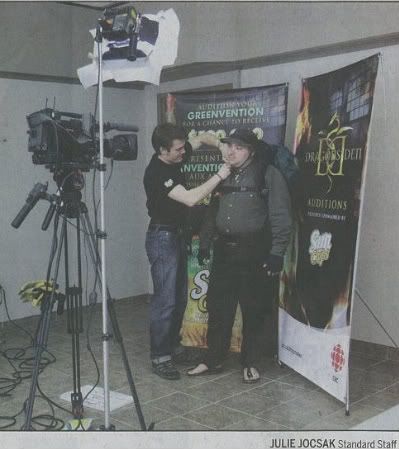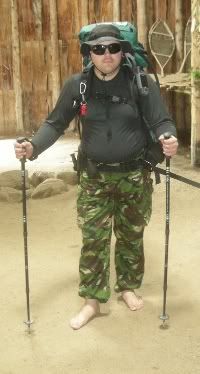
SUBCULTURE
Barefoot hiking
Barefoot hikers get in touch with the land, but can they climb a mountain?
By Scott Berdahl
EIGHT HUNDRED METRES off the valley floor, blades of rock jut out from the mountainside. A cold wind whips across the ridge, but the ground itself is warm in the evening sunlight. Two dozen Dall sheep gaze down at us as we pick our way across vertically-bedded shale, favouring the soft patches of alpine grass, heather and arctic lupine that line the way. My girlfriend Jessica and I are halfway up Caribou Mountain, a 1,900-metre peak about an hour south of Whitehorse. Neither of us is wearing shoes.
Our climb is an experiment of sorts, a sojourn into the world of barefoot hiking. In Canada and abroad, a subset of hikers has done away with footwear, choosing instead to hit the trails unshod. While the idea sounded painful to me at first — perhaps even dangerous — the more I looked into it, the more I wanted to give it a try.
“We’re made to have a lot of feedback from the ground,” says Richard Frazine, author of an informal guidebook called The Barefoot Hiker. Feet are one of the more sensitive parts of the human body, yet we keep them stuffed inside jackets of leather, canvas and rubber, robbing them of tactile input. By ditching shoes, Frazine says, we reclaim a lost sense.
When I trained for this hike, walking sections of my route home from work barefoot, it didn’t take long for Frazine’s point to sink in. At first, grass tickled and almost everything else hurt; the only real plus was that I could cut right through Ottawa’s Rideau River to shave 10 minutes off the commute. As my feet toughened, though, I started to appreciate the different textures underfoot: concrete sidewalks, asphalt roads and even some gravel walkways, which reminded me a bit of crunching on potato chips.
On Caribou Mountain, Frazine’s point is driven home. The trail up shifts from cool, dark soil in aspen groves, laden with hints of the previous day’s rain, to dry ridges, where warm dust envelops our feet as we step between rounded stones and the occasional rose bush. More than just experiencing a new texture, it’s like I have a stethoscope on each stretch of ground that I cover. I’ve done a lot of hiking, but it’s an entirely new experience.
And apparently, I’m doing myself a favour. A growing stack of scientific literature suggests that modern shoes are behind many foot troubles, from athlete’s foot and corns to joint problems and flat arches, to name just a few. One recent study compared modern feet to those of ancient, unshod humans, finding that before we took to shoes, our feet were much healthier.
It makes sense. We’ve had millions of years to evolve since early humans began walking upright. Given the chance, shouldn’t our feet be able to fend for themselves? This thinking has led to a resurgence of faith in the foot, with companies such as Vibram going so far as to release glovelike shoes to simulate barefoot walking.
Wolf Starchild, who runs a guided trekking company in Niagara-on-the-Lake, Ontario is a firm believer in bare feet. Interested in hiking with various clubs, Starchild got sick of hearing people protest that he’d get hurt and they’d have to carry him out. “I really wanted to prove them wrong,” says Starchild.
So in the summer of 2009, he walked the entire length of Ontario’s Bruce Trail in his bare feet. He was fine. “How many people,” asks Starchid, “can say they walked 850 kilometres in a summer without getting a blister?”
But for Jess and I, pressing farther up the ridge, the shale is starting to hurt. While Starchild, who has done some barefoot mountaineering in British Columbia, might not have any difficulty with the terrain, it’s clear that us tenderfoots have wandered out of our league. We stop for a minute to take in the view — the dunes of the Carcross desert spilling over boreal forest in the valley below; the long, blue arms of Bennett Lake stretching away into the peaks of the Coast Mountains — and then start hobbling downward.
A couple of hours later, back at the car, I gaze up at the ridge and then proudly down at my feet. “That,” I say to Jess, “with these.”
Before we head home, however, I put on socks and shoes. My feet revel in the softness, as though they’re hitting a luxurious bed after a hard day. I take a few steps without worrying about where they’re landing. Then I break into a run, down into a ditch, up the far side and onto an outcrop of jagged rock exposed by the road cut. I launch myself out over the scree below and touch down without incident. For all their shortcomings, shoes suddenly don’t seem so bad.
Barefoot hiking
Barefoot hikers get in touch with the land, but can they climb a mountain?
By Scott Berdahl
EIGHT HUNDRED METRES off the valley floor, blades of rock jut out from the mountainside. A cold wind whips across the ridge, but the ground itself is warm in the evening sunlight. Two dozen Dall sheep gaze down at us as we pick our way across vertically-bedded shale, favouring the soft patches of alpine grass, heather and arctic lupine that line the way. My girlfriend Jessica and I are halfway up Caribou Mountain, a 1,900-metre peak about an hour south of Whitehorse. Neither of us is wearing shoes.
Our climb is an experiment of sorts, a sojourn into the world of barefoot hiking. In Canada and abroad, a subset of hikers has done away with footwear, choosing instead to hit the trails unshod. While the idea sounded painful to me at first — perhaps even dangerous — the more I looked into it, the more I wanted to give it a try.
“We’re made to have a lot of feedback from the ground,” says Richard Frazine, author of an informal guidebook called The Barefoot Hiker. Feet are one of the more sensitive parts of the human body, yet we keep them stuffed inside jackets of leather, canvas and rubber, robbing them of tactile input. By ditching shoes, Frazine says, we reclaim a lost sense.
When I trained for this hike, walking sections of my route home from work barefoot, it didn’t take long for Frazine’s point to sink in. At first, grass tickled and almost everything else hurt; the only real plus was that I could cut right through Ottawa’s Rideau River to shave 10 minutes off the commute. As my feet toughened, though, I started to appreciate the different textures underfoot: concrete sidewalks, asphalt roads and even some gravel walkways, which reminded me a bit of crunching on potato chips.
On Caribou Mountain, Frazine’s point is driven home. The trail up shifts from cool, dark soil in aspen groves, laden with hints of the previous day’s rain, to dry ridges, where warm dust envelops our feet as we step between rounded stones and the occasional rose bush. More than just experiencing a new texture, it’s like I have a stethoscope on each stretch of ground that I cover. I’ve done a lot of hiking, but it’s an entirely new experience.
And apparently, I’m doing myself a favour. A growing stack of scientific literature suggests that modern shoes are behind many foot troubles, from athlete’s foot and corns to joint problems and flat arches, to name just a few. One recent study compared modern feet to those of ancient, unshod humans, finding that before we took to shoes, our feet were much healthier.
It makes sense. We’ve had millions of years to evolve since early humans began walking upright. Given the chance, shouldn’t our feet be able to fend for themselves? This thinking has led to a resurgence of faith in the foot, with companies such as Vibram going so far as to release glovelike shoes to simulate barefoot walking.
Wolf Starchild, who runs a guided trekking company in Niagara-on-the-Lake, Ontario is a firm believer in bare feet. Interested in hiking with various clubs, Starchild got sick of hearing people protest that he’d get hurt and they’d have to carry him out. “I really wanted to prove them wrong,” says Starchild.
So in the summer of 2009, he walked the entire length of Ontario’s Bruce Trail in his bare feet. He was fine. “How many people,” asks Starchid, “can say they walked 850 kilometres in a summer without getting a blister?”
But for Jess and I, pressing farther up the ridge, the shale is starting to hurt. While Starchild, who has done some barefoot mountaineering in British Columbia, might not have any difficulty with the terrain, it’s clear that us tenderfoots have wandered out of our league. We stop for a minute to take in the view — the dunes of the Carcross desert spilling over boreal forest in the valley below; the long, blue arms of Bennett Lake stretching away into the peaks of the Coast Mountains — and then start hobbling downward.
A couple of hours later, back at the car, I gaze up at the ridge and then proudly down at my feet. “That,” I say to Jess, “with these.”
Before we head home, however, I put on socks and shoes. My feet revel in the softness, as though they’re hitting a luxurious bed after a hard day. I take a few steps without worrying about where they’re landing. Then I break into a run, down into a ditch, up the far side and onto an outcrop of jagged rock exposed by the road cut. I launch myself out over the scree below and touch down without incident. For all their shortcomings, shoes suddenly don’t seem so bad.




